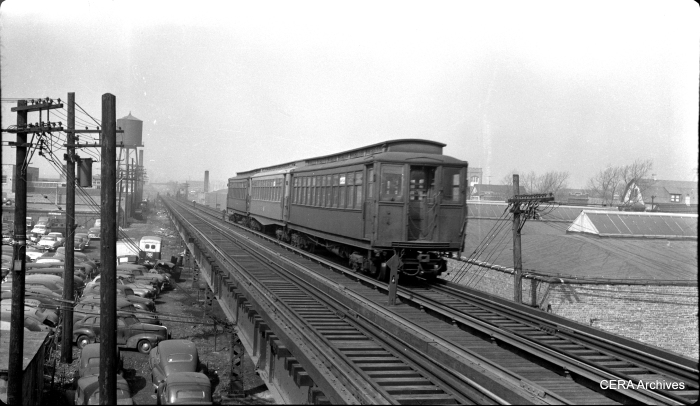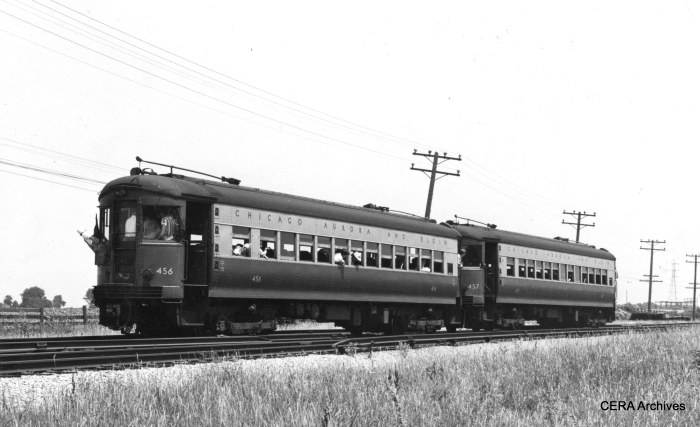Few traces remain today of Chicago’s storied Garfield Park “L”, which was obliterated by construction of the Congress (now Eisenhower) expressway in the 1950s, events that also hastened the demise of the Chicago, Aurora and Elgin interurban. The transition from Garfield to Congress has long been one of our favorite topics, which we have written about at length.

It is not apparent from this early postcard, but the Met bridge over the Chicago River had four tracks.
But today, we offer a sampling of views along the old right-of-way, before the inevitable path of progress affected things. Looking at a route map from 1948, and considering how the western suburbs were expected to develop, we can see how the Garfield line (and its CA&E connections) had a tremendous reach and potential, only partly realized by today’s CTA Blue Line branch to Forest Park.
By the late 1920s, CA&E and CRT, both parts of the far-flung Insull empire, worked together as parts of a harmonious whole. While the Depression put everything under great strain, there were few real changes in services for the next 20 years. But the idea of a rapid transit line in the median of the Congress Parkway Super-Highway took hold by 1939, so change became inevitable.
The Met “L”s were not built to as high a standard as Chicago’s others, and therefore, sooner or later, the structure would have needed complete replacement anyway, as experienced by the Douglas/Pink Line. But not all of the Garfield Line ran in the footprint of today’s Eisenhower expressway. From Sacramento to a point just west of Laramie- a stretch of about three miles- the line ran outside where the highway is today, and this portion could have been retained. Likewise, the portions east of Halsted also veered off from the highway to connect up with the Loop “L”.
The highway plans did not always call for replacing the entire Garfield alignment. According to a 1948 CTA map, the plan at that time was to retain the old portion between Sacramento and Laramie:
On the City of Chicago’s construction program is a West Side Subway as an extension of the Congress Street leg of the Milwaukee-Dearborn-Congress Subway. Crossing under the Chicago river in tubes, it is to emerge near Halsted Street in the strip between the roadways of the Congress Street Superhighway. It is to continue in the median strip of the highway to Kedzie Avenue and then turn north in subway tubes to connect with the Lake Street “L”.
Included in the plan are the construction of two track connections to the Douglas Park and Garfield Park branches at Marshfield Avenue and Sacramento Boulevard, respectively.
Planners also hoped to tear down the Loop “L” in stages, and in order to do this, the Lake Street “L” would need to be relocated into a subway. It was thought this could be done by building a new connection between Lake and the planned Congress line, which would then run downtown via the Dearborn-Milwaukee subway. Whereas the old Met “L” arrangement had three branches coming together at one point (Marshfield junction), these early CTA plans called for separating them, with the Lake and Congress lines coming together at a point further west.
But there were many practical reasons for letting the Lake Street “L” remain, and it and the Loop “L” structure have survived to this day. For one thing, the Lake “L” was built to a higher standard than Garfield or Douglas. Relocating the portion east of Kedzie would do nothing to fix the problems Lake had running at ground level west of Laramie. Routing Lake via Congress would also have slowed down service downtown and back, in the same manner that the Pink Line is slowed down today by being diverted over to Lake.
CTA planners helped improve operations on the Lake Street “L” in 1949 with the introduction of A-B “skip stop” service, and this seems to have quelled the notion of connecting it to Congress. After all, a Lake-Douglas-Congress route would have been a three-headed monster, and CTA was not going to institute an A-B-C service.
We can all be glad that service on the west side lines got rationalized in a better manner than some of the early plans. Unfortunately, expressway construction is also widely regarded as having sped the end of the CA&E, which ceased operating passenger service in 1957.
Opinions are divided on whether CA&E, which was losing money, really wanted to continue at the start of expressway construction. It may be that cutting back service to Forest Park was part of an overall plan for a piecemeal liquidation, in a similar manner to what happened to Lehigh Valley Transit’s Liberty Bell Limited between 1949 and 1951.
CRT’s Westchester branch had great potential, but fell victim both to CA&E’s desire to liquidate its assets (it owned the land) and their desire to sever rail connections with the CTA. Continued CTA rail operations west of Forest Park would have meant keeping the track connection which CA&E cut as soon as their last westbound train passed Forest Park in September 1953. But I am sure CTA wishes it had the Westchester branch back today.
Meanwhile, I hope that you enjoy our Garfield Park “L” photo essay as we turn back the clock to a time before it, and much else of life in the 1950s, was swept away into the dustbin of history.
-David Sadowski


CTA 2818 leads the way west of the Loop in this June 1952 scene. I believe we are looking east from the end of the Racine station.

The three Metropolitan “L” lines met at Marshfield junction. Garfield Park trains are in the center of this postcard view, with Logan Square/Humboldt Park on left and Douglas Park on the right. This is approximately where the Pink Line crosses the Blue Line today.

The Garfield Park’s Cicero station, seen here in the early 1950s, was the westernmost one on a steel elevated structure. Service west continued at ground level. This portion of the line was unaffected by expressway construction and continued in service until the Congress line opened in 1958. It was torn down the following year.

In the early 1950s, a westbound Garfield Park train descends the ramp between the Cicero and Laramie stations.

CA&E steel car 430 at Laramie on July 23, 1933.

According to Don’s Rail Photos, “2721 was built by Barney & Smith in 1895 as Metropolitan-West Side Elevated Ry 721. In 1913 it was renumbered 2721. In 1919 it was rebuilt as a merchandise dispatch car to be leased to the North Shore line. After a short time it was replaced by new and similar MD cars built for the North Shore. It was then returned to the CRT and used in work service. It became CRT 2721 in 1923.” It is shown here in 1941 painted silver. This car was scrapped in March 1959. (The location is the SE corner of Laramie Yard. You can see the elevated ramping up at the right of the picture.)

CRT 2322 in a late 1930s photo by early CERA member La Mar M. Kelley.

CRT Metropolitan Division 2877, shown here in a photo by La Mar M. Kelley, was built in 1906. CERA Bulletin 113 describes this order as “the enclosed vestibule type with manually controlled pneumatically-operated sliding doors and with steel and wood underframes and steel-reinforced wooden bodies.” Work car 2721 is at the rear.

CRT 1805 sports an American flag in this late 1930s photo by La Mar M. Kelley. This may be out on the Westchester branch (note the sparse development and the single track.)

While CRT’s own tracks ended at Laramie, “L” service continued further west as far as Bellwood and Westchester over the tracks of the Chicago, Aurora & Elgin.

The Garfield Park route circa 1952, once the Westchester branch had been replaced by buses. CTA continued to serve the Bellwood/Westchester area with the #17 bus for the next 60 years. The old “L” had lots of stations closely spaced together, and relied on walk-in traffic from densely populated neighborhoods. The Congress line that replaced it speeded up service, in part, by reducing the number of stations.

A CTA summary of Garfield Park service as of 1952, after the Westchester branch closed, but before expressway construction forced a portion of the route to be relocated to temporary tracks on Van Buren street in the city.



If not for expressway construction starting in 1953 (and the resulting Congress median line that opened five years later), CTA might have simply truncated Garfield “L” service at Laramie and used buses west of there. The ground-level route west of there had grade crossings, passing sidings, and even crossed a freight line. No doubt CTA considered this very problematic. Similarly, service on the Douglas Park branch was cut back to 54th avenue in 1952. Proposals to eliminate the ground-level portion of the Lake street “L” around this time eventually led to the outer portion being relocated to the CNW embankment in 1962.

From 1953-57, CA&E service terminated at Forest Park, and passengers desiring to continue further east had to change trains and pay a CTA fare. There were no through tickets.

Joint timetables such as this helped improve the transfer of passengers between CA&E and CTA at Forest Park between 1953-57.


CRT 4317 leads the way on a CERA fantrip on the CA&E’s Mount Carmel branch on February 12, 1939.

The AE&C was the predecessor of the CA&E. Some of its original 1902 equipment included wood car 16, shown here, a sister of car 20, preserved in operating condition at the Fox River Trolley Museum.

CA&E cars 456 and 457 at Batavia Junction on July 3, 1949.

Now we’ve come full circle. Here is another view of the bridge shown at the beginning of this post.